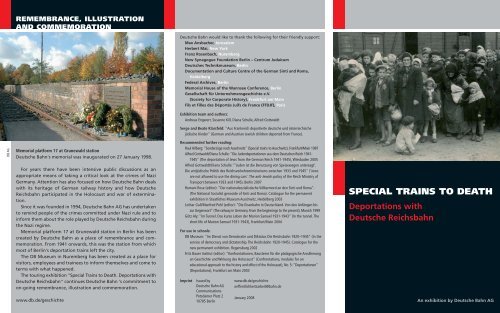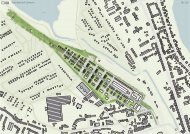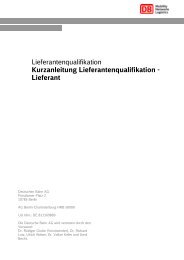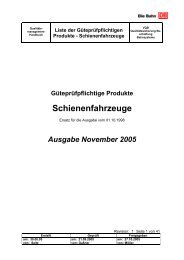Bahn Flyer engl. - Deutsche Bahn AG
Bahn Flyer engl. - Deutsche Bahn AG
Bahn Flyer engl. - Deutsche Bahn AG
Create successful ePaper yourself
Turn your PDF publications into a flip-book with our unique Google optimized e-Paper software.
DB <strong>AG</strong><br />
REMEMBRANCE, ILLUSTRATION<br />
AND COMMEMORATION<br />
Memorial platform 17 at Grunewald station<br />
<strong>Deutsche</strong> <strong>Bahn</strong>'s memorial was inaugurated on 27 January 1998.<br />
For years there have been intensive public discussions as an<br />
appropriate means of taking a critical look at the crimes of Nazi<br />
Germany. Attention has also focused on how <strong>Deutsche</strong> <strong>Bahn</strong> deals<br />
with its heritage of German railway history and how <strong>Deutsche</strong><br />
Reichsbahn participated in the Holocaust and war of extermination.<br />
Since it was founded in 1994, <strong>Deutsche</strong> <strong>Bahn</strong> <strong>AG</strong> has undertaken<br />
to remind people of the crimes committed under Nazi rule and to<br />
inform them about the role played by <strong>Deutsche</strong> Reichsbahn during<br />
the Nazi regime.<br />
Memorial platform 17 at Grunewald station in Berlin has been<br />
created by <strong>Deutsche</strong> <strong>Bahn</strong> as a place of remembrance and commemoration.<br />
From 1941 onwards, this was the station from which<br />
most of Berlin's deportation trains left the city.<br />
The DB Museum in Nuremberg has been created as a place for<br />
visitors, employees and trainees to inform themselves and come to<br />
terms with what happened.<br />
The touring exhibition "Special Trains to Death. Deportations with<br />
<strong>Deutsche</strong> Reichsbahn" continues <strong>Deutsche</strong> <strong>Bahn</strong> 's commitment to<br />
on-going remembrance, illustration and commemoration.<br />
www.db.de/geschichte<br />
<strong>Deutsche</strong> <strong>Bahn</strong> would like to thank the following for their friendly support:<br />
Max Ansbacher, Jerusalem<br />
Herbert Mai, New York<br />
Franz Rosenbach, Nuremberg<br />
New Synagogue Foundation Berlin – Centrum Judaicum<br />
<strong>Deutsche</strong>s Technikmuseum, Berlin<br />
Documentation and Culture Centre of the German Sinti and Roma,<br />
Heidelberg<br />
Federal Archives, Berlin<br />
Memorial House of the Wannsee Conference, Berlin<br />
Gesellschaft für Unternehmensgeschichte e.V.<br />
(Society for Corporate History), Frankfurt am Main<br />
Fils et Filles des Déportés Juifs de France (FFDJF), Paris<br />
Exhibition team and authors:<br />
Andreas Engwert, Susanne Kill, Diana Schulle, Alfred Gottwaldt<br />
Serge and Beate Klarsfeld: "Aus Frankreich deportierte deutsche und österreichische<br />
jüdische Kinder" (German and Austrian Jewish children deported from France).<br />
Recommended further reading:<br />
Raul Hilberg: "Sonderzüge nach Auschwitz" (Special trains to Auschwitz), Frankfurt/Main 1987<br />
Alfred Gottwaldt/Diana Schulle: "Die Judendeportationen aus dem <strong>Deutsche</strong>n Reich 1941-<br />
1945" (The deportation of Jews from the German Reich 1941-1945), Wiesbaden 2005<br />
Alfred Gottwaldt/Diana Schulle: “’Juden ist die Benutzung von Speisewagen untersagt’.<br />
Die antijüdische Politik des Reichsverkehrsministeriums zwischen 1933 und 1945" (‘Jews<br />
are not allowed to use the dining cars’. The anti-Jewish policy of the Reich Ministry of<br />
Transport between 1933 and 1945), Berlin 2007<br />
Romani Rose (editor): "Der nationalsozialistische Völkermord an den Sinti und Roma".<br />
(The National Socialist genocide of Sinti and Roma). Catalogue for the permanent<br />
exhibition in Staatliches Museum Auschwitz, Heidelberg 2003<br />
Lothar Gall/Manfred Pohl (editor): "Die Eisenbahn in Deutschland. Von den Anfängen bis<br />
zur Gegenwart" (The railway in Germany. From the beginnings to the present), Munich 1999<br />
Götz Aly: "Im Tunnel. Das kurze Leben der Marion Samuel 1931-1943" (In the tunnel. The<br />
short life of Marion Samuel 1931-1943), Frankfurt/Main 2004<br />
For use in schools:<br />
DB Museum: "Im Dienst von Demokratie und Diktatur. Die Reichsbahn 1920–1945" (In the<br />
service of democracy and dictatorship. The Reichsbahn 1920-1945). Catalogue for the<br />
new permanent exhibition, Regensburg 2002<br />
Fritz Bauer Institut (editor): "Konfrontationen, Bausteine für die pädagogische Annäherung<br />
an Geschichte und Wirkung des Holocaust" (Confrontations, modules for an<br />
educational approach to the history and effect of the Holocaust), No. 5: "Deportationen"<br />
(Deportations), Frankfurt am Main 2003<br />
Imprint Issued by<br />
<strong>Deutsche</strong> <strong>Bahn</strong> <strong>AG</strong><br />
Communications<br />
Potsdamer Platz 2<br />
10785 Berlin<br />
www.db.de/geschichte<br />
oeffentlichkeitsarbeit@bahn.de<br />
January 2008<br />
SPECIAL TRAINS TO DEATH<br />
Deportations with<br />
<strong>Deutsche</strong> Reichsbahn<br />
An exhibition by <strong>Deutsche</strong> <strong>Bahn</strong> <strong>AG</strong>
SPECIAL TRAINS TO DEATH<br />
Deportation of Jews from Mainfranken, Würzburg April 1942<br />
Federal Archives Würzburg<br />
Deportations with <strong>Deutsche</strong> Reichsbahn<br />
<strong>Deutsche</strong> Reichsbahn was responsible for the deportation of innumerable<br />
people, and thus directly involved in the Holocaust. Without<br />
the railway, the systematic murder of the European Jews, Sinti and<br />
Roma would not have been possible. During World War II, some<br />
three million people from almost the whole of Europe were transported<br />
by train to the Nazi extermination camps.<br />
The exhibition "Special Trains to Death. Deportations with <strong>Deutsche</strong><br />
Reichsbahn" is intended to remind visitors of the immeasurable suffering<br />
caused to these people. The exhibition presents the fates of<br />
individual children, women and men who were taken from their<br />
native towns and transported to the death camps. Interviews with<br />
survivors depict the atrocious conditions on the trains, while documents<br />
and graphics illustrate how these transports were organised<br />
by <strong>Deutsche</strong> Reichsbahn and show the operational procedures.<br />
The touring exhibition was drawn up in cooperation with the Centrum<br />
Judaicum and <strong>Deutsche</strong>s Technikmuseum in Berlin. It is based<br />
on the permanent exhibition at the <strong>Deutsche</strong> <strong>Bahn</strong> Museum in<br />
Nuremberg which shows the history of <strong>Deutsche</strong> Reichsbahn during<br />
the National Socialist era. The photos and biographies of the Jewish<br />
children deported from France were researched and compiled for<br />
the exhibition by Serge and Beate Klarsfeld.<br />
In July 1942, repairs on the railway line to the extermination camp<br />
Sobibor delayed deportation of the people living in the Warsaw<br />
Ghetto. And so through his personal adjutant Karl Wolff, "SS Reichsführer"<br />
Himmler approached the Deputy General Director of <strong>Deutsche</strong><br />
Reichsbahn, State Secretary Albert Ganzenmüller. With Ganzenmüller's<br />
consent, this was soon followed by the deportation of several thousand<br />
men, women and children every day to the recently erected<br />
extermination camp Treblinka. The cooperation is documented by<br />
correspondence.<br />
Steffi Bernheim F. F. D. J. F.<br />
Steffi Bernheim was born on 11 January 1930 in Berlin. The Bernheim<br />
family fled from Germany to France and lived in Paris in rue<br />
de Provence 60. Steffi was arrested during a large-scale raid and<br />
eventually deported to Auschwitz with transport No. 23 on 24<br />
August 1942. Her mother Rebecca had already been brought to<br />
the extermination camp; father Walter and brother Norbert followed<br />
with transport No. 57 on 18 July 1943.<br />
Brothers Gert and Hans Rosenthal<br />
Centrum Judaicum<br />
On 19 October 1942, a transport<br />
left Moabit freight station in<br />
Berlin with 959 people for Riga<br />
in Latvia. Most of the people<br />
who had been in the special<br />
train were taken into the surrounding<br />
woods and shot dead<br />
immediately on arrival.<br />
There were 140 children among<br />
the victims, also including Gert<br />
Rosenthal (born 24 July 1932)<br />
who had lived as an orphan in a<br />
Jewish children's home. Gert<br />
was the younger brother of Hans Rosenthal who later became<br />
known as an entertainer (1925 – 1987). Seventeen year-old Hans<br />
went into hiding and lived in a garden shed where he remained<br />
concealed until the end of the war.

















